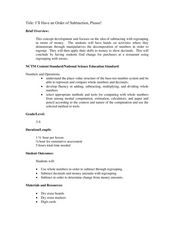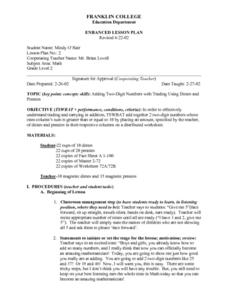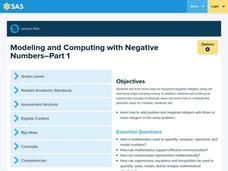Curated OER
Model Counting Pennies and Nickels
First graders provide monetary value of coins. In this counting pennies and nickels lesson, 1st graders practice counting money with a partner.
Curated OER
A Trip to the Toy Store
First graders recognize and identify the value of a penny, nickel and dime. They spend play money in a simulated toy store and match their coins to the purchase price of a toy of their choice.
Curated OER
The Big Buck Adventure: Part 2
Students go on a pretend shopping spree. In this money instructional activity, students complete a Shopping Spree activity sheet where they pretend they have won $100 and can spend it on a fake shopping spree. Students use...
Curated OER
I'll Have an Order of Subtraction Please!
Students explore number values by completing consumer math worksheets. In this math functions lesson, students identify the use of a decimal in numbers and the place values that are represented when dealing with money. Students complete...
Curated OER
Our Town Store
Students purchase items in their classroom store. In this money lesson plan students create a classroom store. The students have a given amount of money and have to decide if they have enough to purchase the items that they would like to.
Curated OER
Adding Two Digit Numbers with Using Dimes and Pennies
Second graders participate in a math game using dimes and pennies. They practice combining coins to make a given amount of money, and they use the combinations to practice adding two digit numbers. Teacher assessment strategies and...
Curated OER
Two of Everything
Students listen to story Two of Everything, illustrate coins they would put into the Magic Pot using paper and pencil, and solve Magic Pot riddles by viewing slide show and predicting coin totals. Students then create table listing...
Curated OER
Buckets of Bucks for World Hunger
Students participate in a nonprofit organization activity for hunger outreach problems. For this service project lesson, students practice counting coins, complete a service project for a hunger outreach, discuss nutrition and healthy...
Curated OER
Dividing with Fractions
Use paper strips or models to relate division problems to division of fraction problems. Since the materials can be broken up, it helps them to show how they can complete repeated subtraction with fractions and not just whole numbers.
Curated OER
Retirement: Show Me the Money!
Students explore the concept of retirement finances. In this retirement finances lesson, students discuss what it means to save, invest, risk, or the time value of money. Students play the stock market game. Students interview a parent...
Curated OER
Christmas Shopping on the Internet
Students utilize the Internet as a research tool as they "shop" on the Internet for a list of Christmas gifts. In groups, they compare prices, shop for the best price and make sure to spend no more than $300.
Visa
A Plan for the Future: Making a Budget
From fixed and variable expenses to gross income and net pay, break down the key terms of budgeting with your young adults and help them develop their own plans for spending and saving.
Curated OER
Million Dollar Project
Students calculate how they will spend a million dollars. In this millionaire math activity, students complete a worksheet and then make a poster of how they would spend a million dollars. Each item and its cost must be...
Curated OER
Solving Problems
Second graders become familiar with need strategies for computation of money problems and estimating sums. In this computation instructional activity, 2nd graders solve real life problems to understand estimation and money problems.
Curated OER
Purchasing Power
Students participate in a lemonade sale and record their sales in a journal. In this fundraising lesson, students donate money they have raised from a lemonade sale and make a plan for how the money should be spent.
Curated OER
Rounding Decimals
Fourth graders explore rounding a price given in dollar and cents to the nearest dollar. In this math lesson, 4th graders discover how to round to the nearest dollar. Additionally, students practice rounding money for objects that they...
Curated OER
The Magic Pot
In this reading comprehension lesson, students use the book "The Magic Pot," to explore many concepts including; story elements, sequencing, and phonics. Students also practice making doubles using coins and "magic pots." This very...
Curated OER
There's No Accountin with Ledgers
Tenth graders create and maintain a ledger, write an essay for the process, and learn to keep financial accounts through the ledger. In this ledger instructional activity, 10th graders define an accounting ledger and create one for the...
Curated OER
Range, Mean, Median and Mode Through the Internet
Students compute measures of central tendency. In this range, mean, median and mode lesson, students gather information on the internet, organize the data and then compute the measures of central tendency. They create a...
Curated OER
The Archer and The Sun
First graders explore Chinese folktales. In this Chinese folktale lesson ,students read Chinese folktales, locate China on a map, and color the Chinese flag. Students are given sentence strips to hold and must arrange themselves in...
Curated OER
Accounting
Students create bank reconciliation spreadsheet. In this algebra lesson, students discuss the basics about business, money and bank accounts. They use a bank reconciliation statement correctly.
Curated OER
Shopping Around
Third graders select a recipe and compare prices for ingredients at two different stores. They select the best place to buy the ingredients and answer questions about the process. They include their data on a spreadsheet related to their...
Curated OER
Money & Work
Twelfth graders explain basic information concerning financial investments. They identify consumer rights and responsibilities and effective practices for purchasing consumer goods, services, housing and insurance. They list steps in...
Curated OER
Money
Second graders show combinations for $1.00. In this dollar combinations lesson, 2nd graders use nickels, dimes, and quarters to model and count combinations equaling $1.00.























